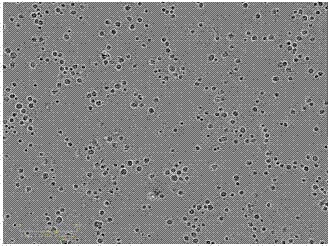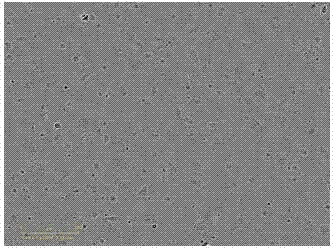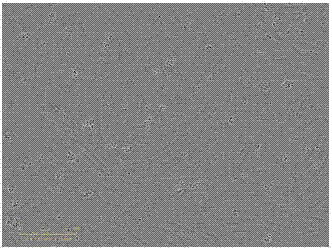CD29<+> human umbilical cord-derived mesenchymal stem cell and application thereof in preparation of bone tissue engineering seed cell used for treating bone injury
A bone tissue engineering, stem cell technology, applied in the direction of bone/connective tissue cells, animal cells, tissue regeneration, etc., can solve problems such as inability to expand in large quantities, body trauma, and little application significance, and achieve broad application prospects, immune The effect of low origin and good therapeutic effect
- Summary
- Abstract
- Description
- Claims
- Application Information
AI Technical Summary
Problems solved by technology
Method used
Image
Examples
Embodiment 1
[0030] Example 1 CD29 + Isolation of mesenchymal stem cells derived from human umbilical cord
[0031] 1.1 Mix 2ul of anti-human CD29 antibody (R&D Systems, US) with 1mg of polylysine (Sigma) at 4°C, and spread it on a 90mm diameter petri dish (Shanghai Jingan Biotechnology Co., Ltd.), overnight at 4°C for standby .
[0032] 1.2 Aseptic operation, wash the umbilical cord with PBS (Gibco) until there is no blood stains and turn white.
[0033] 1.3 Cut the tissue into small sections with ophthalmological scissors, open it longitudinally, and cut the Walton glue into small pieces after removing the blood vessels and the outer skin of the umbilical cord.
[0034] 1.4 Put a small piece of umbilical cord tissue in a 50ml centrifuge tube and cut it into a slurry, add 0.1% collagenase IV (Gibco), digest at 37°C for 2 hours, add an appropriate amount of ɑ-MEM (Gibco) containing 10% fetal bovine serum to culture Mix the solution, centrifuge at 2000g for 10 minutes (L-800R Jiangdong Instruments...
Embodiment 2
[0038] Example 2 Surface marker inspection of human umbilical cord-derived mesenchymal stem cells
[0039] 2.1 Take the 5th generation 1×10 6 Cells / ml, 0.1ml / tube in the flow cytometry tube.
[0040] 2.2 Add directly labeled fluorescent antibodies CD29, CD34, CD45, HLA-DR, CD73, CD90, CD105 (Biolegend, US) and corresponding isotype control antibodies for immunolabeling reaction.
[0041] 2.3 After incubating at 4°C for 20-30 minutes, wash 1-2 times with PBS, and centrifuge to discard the supernatant.
[0042] 2.4 Add 0.5ml PBS buffer to suspend the cells into a single cell suspension.
[0043] 2.5 Use FACSCalibur Flow Cytometer Cellquset Software analysis software for each sample detection.
[0044] The test results are as Figure 4-9 As shown, the human umbilical cord-derived mesenchymal stem cells of the present invention express the following four mesenchymal stem cell membrane molecules: human leukocyte differentiation antigen CD73, human leukocyte differentiation antigen CD90, human...
Embodiment 3
[0045] Example 3 CD29 + Adipogenic differentiation of mesenchymal stem cells derived from human umbilical cord
[0046] 3.1 Select the P5 generation of umbilical cord-derived mesenchymal stem cells with good growth status, and try trypsin digestion when the cell fusion rate reaches 80%-90% fusion.
[0047] 3.2 Inoculate the cells in a six-well plate, about 2.5×10 per well 4 Cells, add 2ml / well of complete culture medium, put them in 37℃, 5% CO 2 Incubate for 24h in an incubator and a hypoxic incubator.
[0048] 3.3 After 24h, remove the old culture medium and add lipid-inducing liquid (α-MEM medium with 10% fetal bovine serum, 0.6mM IBMX, 12mg / L insulin, 10 -5 M dexamethasone and 250 μM indomethacin), induced for 21 days.
[0049] 3.4 Discard the medium in the culture plate, rinse with PBS twice, add 4% neutral formaldehyde, fix for 30 minutes, and suck off the fixative.
[0050] 3.5 Add the freshly prepared and filtered Oil Red O staining solution, dye for 30 minutes, wash 3 times with...
PUM
 Login to View More
Login to View More Abstract
Description
Claims
Application Information
 Login to View More
Login to View More - R&D
- Intellectual Property
- Life Sciences
- Materials
- Tech Scout
- Unparalleled Data Quality
- Higher Quality Content
- 60% Fewer Hallucinations
Browse by: Latest US Patents, China's latest patents, Technical Efficacy Thesaurus, Application Domain, Technology Topic, Popular Technical Reports.
© 2025 PatSnap. All rights reserved.Legal|Privacy policy|Modern Slavery Act Transparency Statement|Sitemap|About US| Contact US: help@patsnap.com



